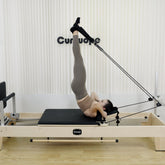Will Pilates help me with muscle loss?Scientific Guide To Pilates And Muscle Loss
Why is muscle loss a concern?
Muscle loss, also known as muscle atrophy, is a common problem that many people face as they age. It can lead to a decrease in strength, mobility, and overall quality of life. However, there are ways to combat muscle loss and maintain a strong and healthy body. One effective method is through Pilates exercises.
Can Pilates Help with Muscle Loss?
Absolutely! Pilates is a fantastic exercise option for individuals who are concerned about muscle loss. It targets specific muscle groups and helps to build lean muscle mass. By regularly practicing Pilates, you can effectively combat muscle loss and maintain a strong, toned physique.

How Does Pilates Prevent Muscle Loss?
Pilates exercises are designed to work multiple muscle groups simultaneously, which helps to increase muscle strength and endurance. The controlled movements and resistance provided by Pilates equipment or body weight create a challenging workout that stimulates muscle growth.
Here are 10 benefits of Pilates for muscle loss:
1. Builds lean muscle mass
Pilates exercises involve controlled movements that target and engage multiple muscle groups. This helps to build lean muscle mass, which is essential for preventing muscle loss.
2. Increases muscle strength
Regular Pilates practice can significantly increase muscle strength. By challenging the muscles with resistance and controlled movements, Pilates helps to strengthen and tone the body.
3. Improves muscle flexibility
Pilates incorporates stretching exercises that improve muscle flexibility. Increased flexibility reduces the risk of muscle injuries and enhances overall muscle function.
4. Enhances muscle endurance
Pilates workouts involve holding positions and performing repetitive movements, which helps to improve muscle endurance. This allows the muscles to work efficiently for longer periods without fatigue.
5. Corrects muscle imbalances
Pilates exercises focus on balancing the muscles on both sides of the body. By correcting muscle imbalances, Pilates helps to prevent muscle loss and promotes overall body symmetry.
6. Promotes proper posture
Poor posture can contribute to muscle loss and weakness. Pilates emphasizes proper alignment and core engagement, which helps to improve posture and prevent muscle imbalances.
7. Increases bone density
Pilates is a weight-bearing exercise that helps to increase bone density. Stronger bones are less prone to fractures and can support healthy muscle development.
8. Enhances joint stability
Pilates exercises focus on improving joint stability and mobility. Strong and stable joints provide a solid foundation for muscle strength and prevent muscle loss due to joint instability.
9. Reduces the risk of injury
By strengthening the muscles and improving flexibility, Pilates reduces the risk of muscle and joint injuries. This allows individuals to engage in other physical activities without the fear of muscle loss or damage.
10. Boosts overall body strength
Regular Pilates practice leads to overall body strength improvement. Strong muscles are more resistant to muscle loss and provide better support for daily activities.
Scientific Evidence Supporting Pilates
Several scientific studies have investigated the effects of Pilates on muscle loss and overall muscle health. These studies have consistently shown positive outcomes, including increased muscle strength, improved flexibility, and enhanced muscle endurance.
By engaging in regular Pilates workouts, individuals can slow down the process of muscle atrophy and even reverse it to some extent.
10 Pilates exercises to combat muscle loss:
1. The Hundred: This exercise targets the abdominal muscles and helps improve core strength.
2. Roll Up: This exercise focuses on the muscles of the spine and helps improve flexibility.
3. Single Leg Circles: This exercise targets the hip muscles and improves stability and balance.
4. Bridge: This exercise strengthens the glutes and hamstrings, which are important for overall lower body strength.
5. Side Plank: This exercise targets the oblique muscles and helps improve core stability.
6. Scissors: This exercise works the muscles of the legs and helps improve flexibility and strength.
7. Swimming: This exercise targets the muscles of the back and helps improve posture.
8. Teaser: This exercise engages the abdominal muscles and helps improve core strength and stability.
9. Leg Pull Front: This exercise targets the muscles of the arms and shoulders, improving upper body strength.
10. Spine Stretch Forward: This exercise focuses on the muscles of the spine and helps improve flexibility and posture.
Getting Started with Pilates
If you're interested in trying Pilates to combat muscle loss, here are a few tips to get started:
1. Find a Qualified Instructor: Look for a certified Pilates instructor who can guide you through the proper techniques and exercises.
2. Start Slowly: Begin with beginner-level Pilates classes or exercises and gradually increase the intensity as your strength and flexibility improve.
3. Consistency is Key: Aim to practice Pilates at least 2-3 times per week to see noticeable results in muscle strength and tone.
4. Listen to Your Body: Pay attention to how your body feels during and after each Pilates session. If something doesn't feel right, modify the exercise or consult with your instructor.
Conclusion
Pilates is a highly effective exercise method for combating muscle loss and improving overall muscle health. By incorporating Pilates into your fitness routine, you can build lean muscle, improve flexibility, enhance core strength, and enjoy numerous other benefits. So why wait? Start your Pilates journey today and say goodbye to muscle loss!





